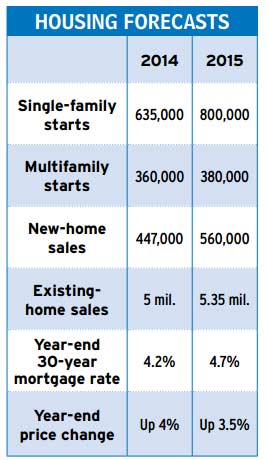Housing Market Will Improve in 2015
The lagging sector is new single family homes, where a shortage of skilled labor and buildable lots is holding back construction.

Eight years after heading into the tank, the housing market is finally nearing normal. Come 2015, sales of existing homes are likely to match or top the average for 1999-2002, before home buying mania seized the U.S. A strong rental market already has the construction of multifamily dwellings back to that historical norm.
The big exception is new single-family homes. Both construction and sales of them are running at just 50% of their pre-bubble levels, and they won’t regain those norms until at least 2017. Demand is lagging for a couple of reasons: New homes tend to be more expensive than older ones, limiting the pool of buyers with the credit to buy them. And a paucity of first-time buyers means fewer owners of existing homes are able to sell and move up to a larger, more costly home.

But supply is also a constraint. Builders can’t keep up even with the currently muted level of demand, according to the National Association of Home Builders.. These days, a new home typically sits on the market for just three months versus the four or five of the past. There aren’t enough skilled tradesmen: carpenters, framers and others who left the field in droves when the bubble burst. There are too few build-ready lots. It takes 15-36 months to prepare sites—building roads, water and sewer lines, bringing in electricity and so on, plus clearing regulatory hurdles. In some localities, jumping through the regulatory hoops alone can take up to seven years. Making matters worse, many lenders—gun-shy after the steep plunge in housing prices—have been loath to lend for development of raw land. So only builders with deep pockets are able to create new subdivisions. Though all these pressures are easing, it will take time for them to disappear.

Sign up for Kiplinger’s Free E-Newsletters
Profit and prosper with the best of expert advice on investing, taxes, retirement, personal finance and more - straight to your e-mail.
Profit and prosper with the best of expert advice - straight to your e-mail.
Meanwhile, for the housing market as a whole, several positives are at work: Credit is getting easier. Half of mortgage lenders surveyed expect improved access to credit for lower prime borrowers (FICO scores of 620 to 720) over the next six months. Lenders are becoming more comfortable with the standards for loans that can be off-loaded to Fannie Mae or Freddie Mac, soothing their concerns. (Parallel rules for mortgages that can be securitized and sold will kick in next year.) So there’s more flexibility on debt-to-income ratios, and minimum down payments are sliding from 5% to 3% for Fannie- and Freddie-conforming loans, for example.
Of course, compared with the boom years, mortgages are still much harder to obtain. About half of mortgages still go to borrowers with FICO scores above 740. Though that’s better than the 60% such borrowers accounted for in 2013, it’s far more restrictive than in the early 2000s, when the average borrower score was 680. The Federal Reserve’s July 2014 Senior Loan Officer Opinion Survey on Bank Lending Practices indicated that half of mortgage loan officers considered conditions still to be tighter than average.
Also helping are higher incomes and employment; more consumers can afford purchases. In addition, there are a million more potential home buyers than usual—a backlog of young adults still living with their parents but eager to strike out on their own as soon as possible. Mortgage rates will remain modest, despite a likely slow climb over the coming year.
As for prices, we expect them to increase more slowly in 2015, now that the first pendulum swing from downturn to upturn is over and investors are seeking better returns elsewhere.
Get Kiplinger Today newsletter — free
Profit and prosper with the best of Kiplinger's advice on investing, taxes, retirement, personal finance and much more. Delivered daily. Enter your email in the box and click Sign Me Up.

David is both staff economist and reporter for The Kiplinger Letter, overseeing Kiplinger forecasts for the U.S. and world economies. Previously, he was senior principal economist in the Center for Forecasting and Modeling at IHS/GlobalInsight, and an economist in the Chief Economist's Office of the U.S. Department of Commerce. David has co-written weekly reports on economic conditions since 1992, and has forecasted GDP and its components since 1995, beating the Blue Chip Indicators forecasts two-thirds of the time. David is a Certified Business Economist as recognized by the National Association for Business Economics. He has two master's degrees and is ABD in economics from the University of North Carolina at Chapel Hill.
-
 Sam's Club Plans Aggressive Expansion: Discover Its New Locations
Sam's Club Plans Aggressive Expansion: Discover Its New LocationsSam's Club expansion plans will open up to 15 new stores each year. Learn where they plan to open in 2025.
By Sean Jackson Published
-
 What Is the Buffett Indicator?
What Is the Buffett Indicator?"It is better to be roughly right than precisely wrong," writes Carveth Read in "Logic: Deductive and Inductive." That's the premise of the Buffett Indicator.
By Charles Lewis Sizemore, CFA Published
-
 The AI Doctor Coming to Read Your Test Results
The AI Doctor Coming to Read Your Test ResultsThe Kiplinger Letter There’s big opportunity for AI tools that analyze CAT scans, MRIs and other medical images. But there are also big challenges that human clinicians and tech companies will have to overcome.
By John Miley Published
-
 The New Space Age Takes Off
The New Space Age Takes OffThe Kiplinger Letter From fast broadband to SOS texting, space has never been more embedded in peoples’ lives. The future is even more exciting for rockets, satellites and emerging space tech.
By John Miley Published
-
 Rising AI Demand Stokes Undersea Investments
Rising AI Demand Stokes Undersea InvestmentsThe Kiplinger Letter As demand soars for AI, there’s a need to transport huge amounts of data across oceans. Tech giants have big plans for new submarine cables, including the longest ever.
By John Miley Published
-
 What DOGE is Doing Now
What DOGE is Doing NowThe Kiplinger Letter As Musk's DOGE pursues its ambitious agenda, uncertainty and legal challenges are mounting — causing frustration for Trump.
By Matthew Housiaux Published
-
 A Move Away From Free Trade
A Move Away From Free TradeThe Letter President Trump says long-term gain will be worth short-term pain, but the pain could be significant this year.
By David Payne Published
-
 Trump’s Whirlwind Month of Crypto Moves
Trump’s Whirlwind Month of Crypto MovesThe Kiplinger Letter The Trump administration wants to strengthen U.S. leadership in the cryptocurrency industry by providing regulatory clarity.
By Rodrigo Sermeño Published
-
 Donald Trump Tests His Limits
Donald Trump Tests His LimitsThe Kiplinger Letter President Encounters Legal Obstacles in Pursuit of Ambitious Agenda.
By Matthew Housiaux Published
-
 Another Down Year for Agriculture
Another Down Year for AgricultureThe Kiplinger Letter Farmers brace for falling incomes, widening trade deficits
By Matthew Housiaux Published